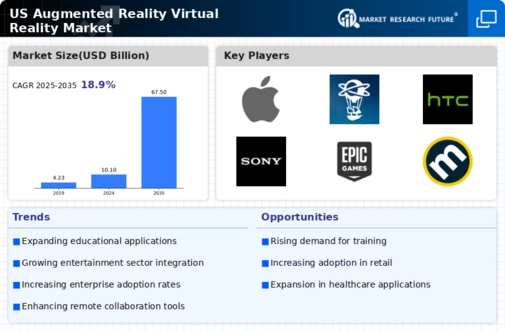Expansion of Healthcare Applications
The augmented virtual-reality-hardware market is experiencing growth due to the expansion of applications in the healthcare sector. Medical professionals are increasingly utilizing augmented virtual-reality technologies for surgical training, patient treatment, and rehabilitation. These applications not only improve the quality of care but also enhance the training of healthcare providers. Recent data indicates that the healthcare segment is expected to account for over 25% of the market share by 2026, reflecting the growing recognition of augmented virtual-reality's potential in improving patient outcomes. As healthcare providers continue to adopt these technologies, the augmented virtual-reality-hardware market is poised for substantial growth.
Increased Investment from Tech Giants
The augmented virtual-reality-hardware market is benefiting from substantial investments by major technology companies. Firms such as Facebook, Google, and Microsoft are pouring resources into research and development, aiming to create next-generation hardware that meets consumer and enterprise needs. This influx of capital not only accelerates innovation but also enhances competition within the market. Recent estimates suggest that investments in augmented virtual-reality technologies could exceed $20 billion by 2025, indicating a strong belief in the market's potential. As these tech giants continue to push the boundaries of what is possible, the augmented virtual-reality-hardware market is likely to see significant advancements and a broader adoption across various industries.
Technological Advancements in Hardware
The augmented virtual-reality-hardware market is experiencing rapid technological advancements that enhance user experience and performance. Innovations in processing power, display technology, and sensor accuracy are driving the development of more sophisticated devices. For instance, the introduction of high-resolution displays and low-latency processing has improved immersion, making applications in gaming and training more effective. According to recent data, the market is projected to grow at a CAGR of approximately 30% over the next five years, indicating a robust demand for cutting-edge hardware. These advancements not only attract consumers but also encourage businesses to invest in augmented virtual-reality solutions, thereby expanding the market's reach across various sectors.
Growing Demand in Education and Training
The augmented virtual-reality-hardware market is witnessing a surge in demand from the education and training sectors. Institutions are increasingly adopting augmented virtual-reality technologies to create immersive learning environments that enhance engagement and retention. For example, simulations in medical training or virtual field trips in schools provide experiential learning opportunities that traditional methods cannot match. This trend is supported by a report indicating that educational institutions are expected to allocate over $10 billion towards augmented virtual-reality solutions by 2026. As educational institutions recognize the benefits of augmented virtual-reality, the market is likely to expand significantly, fostering innovation and development in hardware.
Rising Popularity of Gaming and Entertainment
The augmented virtual-reality-hardware market is significantly influenced by the rising popularity of gaming and entertainment. As consumers seek more immersive experiences, the demand for high-quality augmented virtual-reality devices has surged. The gaming industry, in particular, is projected to reach a valuation of $200 billion by 2025, with augmented virtual-reality playing a crucial role in this growth. This trend is further supported by the increasing number of augmented virtual-reality titles being developed, which enhances the appeal of dedicated hardware. Consequently, the augmented virtual-reality-hardware market is likely to expand as more gamers invest in devices that offer unparalleled experiences.
























Leave a Comment